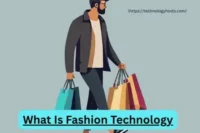What Is Fashion Technology? Beginner’s Guide 2025
Published: 06 Jun 2025
Fashion is no longer just about fabric and style — it’s about innovation. With technology entering the fashion world, brands are creating smarter, more sustainable, and more personalized clothing than ever before.
From smartwatches to virtual fitting rooms, fashion technology is changing how we shop, wear, and experience clothing. Let’s explore what fashion technology really means and how it’s shaping the future of fashion.
What is Fashion Technology?
Fashion technology is the integration of advanced digital tools and innovations into the fashion industry. It enhances the way clothing is designed, manufactured, marketed, and experienced. By combining creativity with technology, it allows for smarter production, personalized shopping, and sustainable solutions. This shift is not only transforming the fashion world but also how consumers interact with it—making fashion more efficient, accessible, and engaging.
Key examples of fashion technology include:
- Smart clothing with health or fitness tracking
- 3D printing for custom and digital garment creation
- Virtual fitting rooms for online shopping
- Fashion design software for digital prototyping
- Eco-friendly fabrics developed through scientific innovation
- Augmented reality tools for virtual try-ons.

History and Evolution of Fashion Technology
Fashion technology has come a long way from manual stitching to smart clothing. It started with basic inventions like the sewing machine and evolved through industrial manufacturing, digital design, and now, intelligent fashion solutions. As consumer demands and technology have advanced, the fashion world has continuously adapted to stay faster, smarter, and more sustainable.
Key milestones in fashion technology development:
- Invention of the sewing machine in the 1800s
- Rise of factory-based clothing production
- Use of synthetic materials like polyester and nylon
- Introduction of computer-aided design (CAD) in fashion
- Digital fashion sketching and prototyping
- Launch of 3D printing for creating wearable garments
- Development of wearable devices like smartwatches
- Integration of AR and VR in retail stores
- Adoption of AI for trend forecasting and personalization.
Key Areas of Fashion Technology
Fashion technology covers a wide range of tools and innovations that are shaping the future of the fashion industry. These areas focus on improving design, production, customer experience, and sustainability. Each one plays a unique role in how fashion is evolving today.
Major areas of fashion technology include:
- Smart Wearables: Clothing or accessories with sensors (e.g., fitness trackers, smart jackets)
- 3D Printing: Allows designers to create detailed, custom-fit garments
- Virtual Try-Ons: Customers can try clothes using AR on mobile or in-store screens
- Fashion Design Software: Tools like CAD for digital sketches and patterns
- Sustainable Fashion Tech: Tech-driven fabric recycling and eco-friendly materials
- E-Commerce Tech: AI recommendations, chatbots, and digital showrooms
- Blockchain in Fashion: For secure supply chain tracking and anti-counterfeiting.
Benefits of Fashion Technology
Fashion technology brings many advantages to the industry, improving efficiency, creativity, and sustainability. It helps designers and brands work faster while offering customers more personalized and convenient experiences. Additionally, fashion tech plays a crucial role in reducing waste and supporting eco-friendly practices, which is vital for the planet.
Key benefits include:
- Speeds up the design and production process
- Enables custom and personalized clothing
- Reduces fabric waste and environmental impact
- Improves customer shopping experience with virtual try-ons
- Enhances inventory and supply chain management
- Facilitates innovation with new materials and wearable tech
- Increases accessibility through online platforms and apps.
Challenges in Fashion Technology
Despite its many benefits, fashion technology also faces several challenges. High costs and technical complexities can limit adoption, especially for smaller brands. Additionally, there are concerns about data privacy, sustainability, and the impact of rapid technological change on traditional craftsmanship and jobs.
Common challenges include:
- High development and implementation costs
- Resistance to change within the industry
- Privacy and security issues with customer data
- Environmental impact of electronic waste
- Balancing technology with traditional design skills
- Keeping up with rapid innovation and market demands.
The Future of Fashion Technology
The future of fashion technology looks exciting and full of innovation. Advances in artificial intelligence, virtual reality, and sustainable materials will continue to transform how fashion is created and experienced. We can expect more personalized shopping, smarter garments, and digital fashion experiences that blur the line between physical and virtual worlds.
Upcoming trends include:
- AI-powered personal stylists and trend forecasting
- Virtual fashion shows and digital clothing in the metaverse
- Smart fabrics that adapt to the wearer’s environment
- Increased use of biodegradable and recycled materials
- Blockchain for transparent and ethical supply chains
- Enhanced virtual try-on and shopping experiences.
Real-Life Examples of Fashion Technology
Fashion technology is no longer just a concept — it’s actively shaping the industry with impressive innovations. Here are some real-world examples that show how technology is transforming fashion today:
Nike’s Self-Lacing Shoes
Nike introduced shoes that automatically tighten around your feet, combining comfort and cutting-edge tech. These shoes use sensors and motors, offering a futuristic and customizable fit.
AR Mirrors in Zara Stores
Zara has implemented augmented reality mirrors in select stores. Customers can see how outfits look on them without physically trying them on, making shopping faster and more interactive.
Virtual Fashion Shows
With the rise of digital platforms, fashion shows are moving online. Designers showcase their collections in virtual environments, allowing global audiences to attend without traveling.
Digital Clothing and NFTs
Some brands now sell digital-only clothing as NTFs, allowing users to dress their avatars or share exclusive fashion pieces online. This new trend blends fashion with the digital art world.
Impact of Fashion Technology on the Industry
Fashion technology is not just about gadgets and innovations; it’s transforming the entire fashion ecosystem. Brands can now reduce their environmental footprint by adopting sustainable materials and more efficient production methods. Technology also empowers designers to experiment with new styles and materials that were once impossible to create.
Moreover, customers benefit from a more personalized and seamless shopping experience. Virtual try-ons and AI recommendations make it easier to find the perfect fit and style without leaving home. This shift also opens up fashion to a global audience, breaking down traditional barriers of access and affordability.
How Consumers Are Embracing Fashion Technology
Consumers today are more tech-savvy and expect convenience and customization in every purchase. Fashion technology meets these demands by offering digital wardrobes, smart clothing that tracks health, and interactive online shopping platforms. Social media and influencer collaborations further drive the adoption of fashion tech, making it a central part of modern lifestyle and culture.
Additional Insights on Fashion Technology
- Enables mass customization, allowing customers to personalize their clothing
- Helps reduce overproduction and inventory waste through data-driven demand forecasting
- Supports sustainable fashion by developing biodegradable and recycled materials
- Improves supply chain transparency with blockchain technology
- Enhances customer engagement via virtual showrooms and immersive shopping experiences
- Encourages collaboration between tech experts and fashion designers for innovative products
- Provides real-time feedback through wearable tech, improving garment functionality and comfort
- Boosts online sales by reducing return rates with accurate virtual fitting tools.
Conclusion
Fashion technology is reshaping the way we design, produce, and experience clothing. By merging creativity with innovation, it offers exciting possibilities for smarter, more sustainable, and personalized fashion. As technology continues to advance, the fashion industry will keep evolving, making style not only more accessible but also more connected to the digital world. Staying informed about these changes helps both consumers and creators embrace the future of fashion with confidence and excitement.
What does fashion technology primarily combine?
a) Style and marketing
b) Creativity and technology
c) Traditional sewing and fabrics
d) Advertising and sales
Which invention significantly boosted clothing production in the 1800s?
a) 3D printer
b) Sewing machine
c) Virtual fitting room
d) Smartwatch
What is a common use of 3D printing in fashion?
a) Creating digital fashion shows
b) Printing custom-fit garments
c) Monitoring health through clothes
d) Selling clothes online
How does augmented reality help in fashion retail?
a) It creates new fabric types
b) It lets customers virtually try clothes
c) It manufactures clothes faster
d) It tracks customer purchases
Which technology helps ensure supply chain transparency?
a) AI
b) Blockchain
c) VR
d) CAD
What is one benefit of fashion technology for the environment?
a) Increased fabric waste
b) Faster production with no waste
c) Development of eco-friendly materials
d) More plastic packaging
Smart clothing can:
a) Change color automatically
b) Monitor your health and fitness
c) Make clothes waterproof
d) Produce energy






